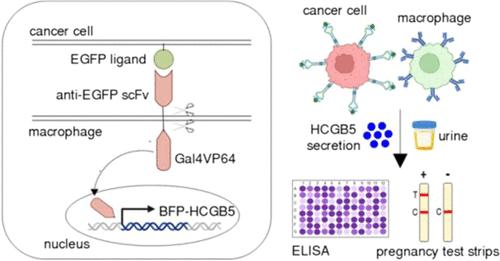Our official English website, www.x-mol.net, welcomes your
feedback! (Note: you will need to create a separate account there.)
SynNotch-Programmed Macrophages for Cancerous Cell Detection and Sensing
ACS Sensors ( IF 8.2 ) Pub Date : 2024-11-04 , DOI: 10.1021/acssensors.4c01997 Tao Wang, Cia-Hin Lau, Naian Wang, Jiaqi Li, Jianchao Wang, Zhihao Huang, Weidong Wu, Xiaoqing Chen, Jiahui Li, Minghai Zou, Wenju Zhang, Yulin Li, Jingrong Li, Wenkai Ma, Yumei Huang, Meijing Xu, Haibao Zhu, Gang Chen
ACS Sensors ( IF 8.2 ) Pub Date : 2024-11-04 , DOI: 10.1021/acssensors.4c01997 Tao Wang, Cia-Hin Lau, Naian Wang, Jiaqi Li, Jianchao Wang, Zhihao Huang, Weidong Wu, Xiaoqing Chen, Jiahui Li, Minghai Zou, Wenju Zhang, Yulin Li, Jingrong Li, Wenkai Ma, Yumei Huang, Meijing Xu, Haibao Zhu, Gang Chen

|
Synthetic Notch (synNotch) receptors have enabled mammalian cells to sense extracellular ligands and respond by activating user-prescribed transcriptional programs. Based on the synNotch system, we describe a cell-based in vivo sensor for cancerous cell detection. We attempted to engineer synNotch-programmed macrophages to sense cancer cells via urinary analysis of human chorionic gonadotropin (HCGB5). Principally, when the synNotch receptors of macrophages bind to the ligands of cancer cells, Notch is activated and undergoes intramembrane proteolysis to release the transcriptional activator into the nucleus. The transcriptional activator targets and activates downstream gene expression, such as human chorionic gonadotropin (HCGB5) in macrophages. When HCGB5 is secreted extracellularly into urine, it can be detected with commercial HCGB5 colloidal gold test strips. As a proof of principle, we demonstrated the feasibility of synNotch-programmed macrophages in detecting breast cancer cells engineered with artificial EGFP ligands. We demonstrated that HCGB5 expression was only induced when the cancer cell expressing EGFP ligands is present; thereby, extracellular HCGB5 expression is directly proportional to the number of cancer cells. Further optimizations of the synNotch system can realize the ultimate goal of establishing cell-based in vivo sensors as the paragon of cancer diagnostics for point-of-care testing and home self-test.
中文翻译:

用于癌细胞检测和传感的 SynNotch 程序巨噬细胞
合成 Notch (synNotch) 受体使哺乳动物细胞能够感知细胞外配体,并通过激活用户规定的转录程序来做出反应。基于 synNotch 系统,我们描述了一种用于癌细胞检测的基于细胞的体内传感器。我们试图通过对人绒毛膜促性腺激素 (HCGB5) 的尿液分析来设计 synNotch 编程的巨噬细胞来感知癌细胞。原则上,当巨噬细胞的 synNotch 受体与癌细胞的配体结合时,Notch 被激活并经历膜内蛋白水解以将转录激活剂释放到细胞核中。转录激活剂靶向并激活下游基因表达,例如巨噬细胞中的人绒毛膜促性腺激素 (HCGB5)。当 HCGB5 从细胞外分泌到尿液中时,可以用市售的 HCGB5 胶体金试纸进行检测。作为原理证明,我们证明了 synNotch 程序巨噬细胞检测用人工 EGFP 配体改造的乳腺癌细胞的可行性。我们证明,只有当存在表达 EGFP 配体的癌细胞时,才会诱导 HCGB5 表达;因此,细胞外 HCGB5 表达与癌细胞的数量成正比。synNotch 系统的进一步优化可以实现建立基于细胞的体内传感器作为即时检测和家庭自检癌症诊断典范的最终目标。
更新日期:2024-11-05
中文翻译:

用于癌细胞检测和传感的 SynNotch 程序巨噬细胞
合成 Notch (synNotch) 受体使哺乳动物细胞能够感知细胞外配体,并通过激活用户规定的转录程序来做出反应。基于 synNotch 系统,我们描述了一种用于癌细胞检测的基于细胞的体内传感器。我们试图通过对人绒毛膜促性腺激素 (HCGB5) 的尿液分析来设计 synNotch 编程的巨噬细胞来感知癌细胞。原则上,当巨噬细胞的 synNotch 受体与癌细胞的配体结合时,Notch 被激活并经历膜内蛋白水解以将转录激活剂释放到细胞核中。转录激活剂靶向并激活下游基因表达,例如巨噬细胞中的人绒毛膜促性腺激素 (HCGB5)。当 HCGB5 从细胞外分泌到尿液中时,可以用市售的 HCGB5 胶体金试纸进行检测。作为原理证明,我们证明了 synNotch 程序巨噬细胞检测用人工 EGFP 配体改造的乳腺癌细胞的可行性。我们证明,只有当存在表达 EGFP 配体的癌细胞时,才会诱导 HCGB5 表达;因此,细胞外 HCGB5 表达与癌细胞的数量成正比。synNotch 系统的进一步优化可以实现建立基于细胞的体内传感器作为即时检测和家庭自检癌症诊断典范的最终目标。


















































 京公网安备 11010802027423号
京公网安备 11010802027423号